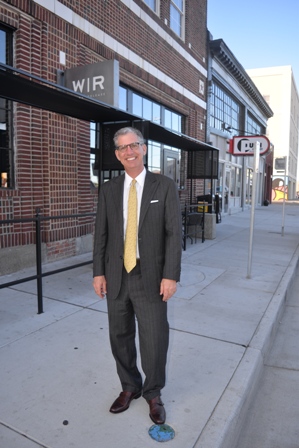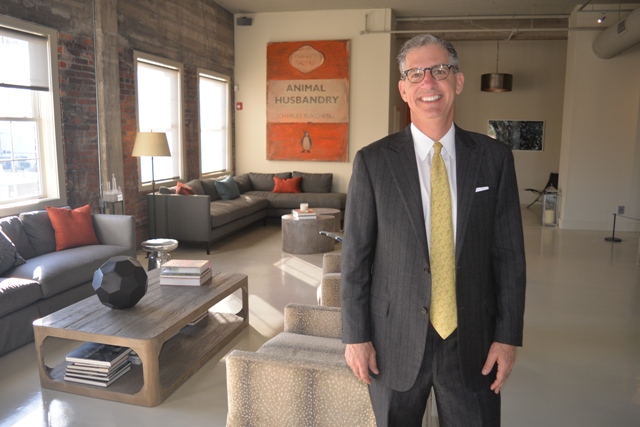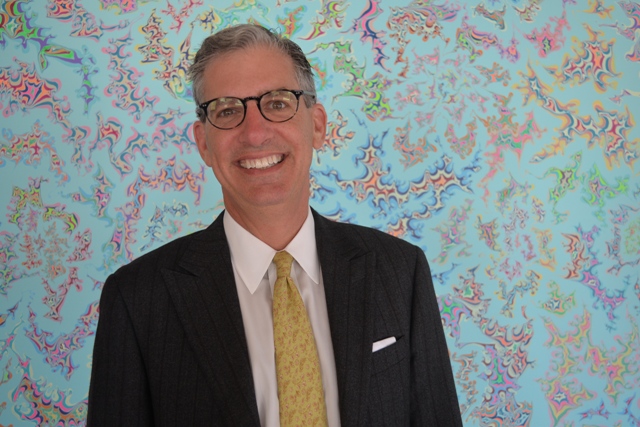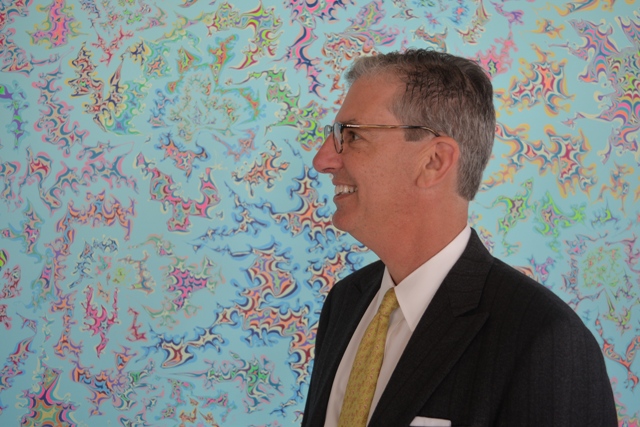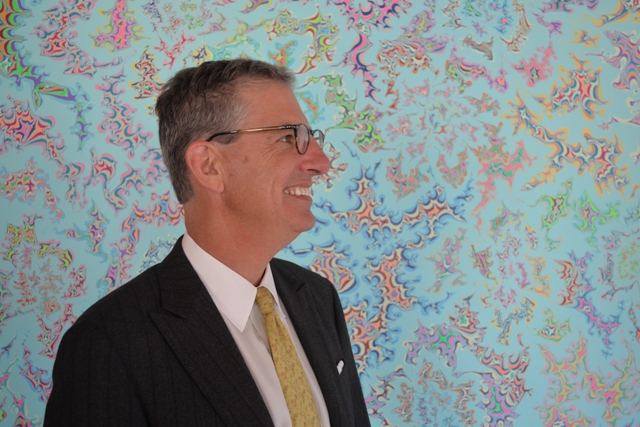By Jeff Maisey
Brother Rutter has searched the world over – the art world that is – and found his true love in Norfolk.
Rutter, as you may know, is C. Arthur “Brother” Rutter of Rutter Mills Injury Law in downtown Norfolk.
What you may not know is that Brother grew up in Virginia Beach. He went to Norfolk Academy through twelfth grade and then attended Harvard for his under graduate work before earning his law degree at the University of Richmond.
Rutter and his future wife, Meredith, had spent time living in New York City before moving back to Virginia Beach in 1991. It was during his Big Apple years that Rutter grew to appreciate visual art.
Fast forward to 2015, Brother and Meredith established the Rutter Family Art Foundation, which operates on the third floor of the old Texaco building in Norfolk’s new Arts & Design District.
The Rutters have an illuminating story to share about their passion for contemporary art and a means to expose a wider audience to it.
Since Brother Rutter is such a great storyteller himself, I thought readers would especially appreciate the following Q&A. I think you’ll be inspired by the Rutter’s commitment to the arts.
How was living in New York City during the 1980s?
I moved to New York in 1986. In the late ‘80s SoHo was very ascendant with the Mary Boone Gallery and the Sonnabend Gallery. It really moved the center of the art world in New York from the Upper East Side down to SoHo, and very quickly down to the Lower East Side with Keith Haring’s Pop Shop and some of the newer, more cutting-edge galleries.
My wife and I both loved art. She worked at Sotheby’s. We did gallery crawls and brunches every weekend in those areas; went to museums. We used art as our entertainment in the city because we would go through galleries and museums for free. It was fun and exciting. That was where the fun people were. That art scene downtown, New York, late ‘80s was just gritty enough that we felt like we still had rebel streaks in us. It was affordable because everyone else was like we were. We were young, just getting started in our careers. Nobody had, really, any money. There were the pop-up bars and clubs that you found out about the day before where they were going to be. It was just an exciting scene. So we got attracted to that sort of art scene emotionally, socially, intellectually at the same time. It was a cool time.
How did you adjust moving from that sort of lifestyle to Hampton Roads in 1991?
It was a bit of an adjustment and we talked about it, but we didn’t have any children at that time. The first four, almost five years we traveled back to New York a fair amount. We went to see friends on the weekend. We didn’t have anything tying us down so we could be spontaneous about where we went.
As soon as we had children we really didn’t think about what we were missing because our attention was completely focused on home.
As time went on we started to miss it a little bit. We are on the Contemporary Art Collectors Committee at the National Gallery; we go to New York a fair amount; we travel to a lot of different cities to get our art fix.
Today we can get our art fix and have that social, emotional and intellectual connection to art right here in our backyard. Watching that happen over the last 20 years has been absolutely wonderful.
How did you and Meredith because engaged in the recently designated Arts & Design District in Norfolk?
I guess it was a couple of different threads pulling at us from different directions. We had been collecting contemporary art fairly heavily for a while and that brought us into the museum world. My wife is currently the Chairman of the Board of Trustees at Virginia Museum of Contemporary Art. I serve on the Board of Trustees at the Chrysler and am head of their Exhibitions Committee. We’re both on the Contemporary Art Exhibitions Committee at the National Gallery.
So we were already engaged in the local and regional art scene from an institutional standpoint. We were at the point where we wanted to do something to support artists and art organizations. We want to take this personal passion that we use to inform our travel and our collecting, and we wanted to broaden our passion to support other people and bring this love of contemporary art to a wider community.
What we realized really quickly is we would only be observers in cities like New York or LA or London or DC. To make a difference in those cities you probably would have to have lived there your whole life and you probably have to have incredible wealth.
We realized we were able to make a difference, move the needle in our own backyard. So we committed ourselves not to fly away to different places for our personal passion, but to stick right here at home and try to make a difference for the art community and create a community in our own backyard.
We love this area. I grew up here. We raised our children here.
Interesting, as we were thinking about all that, the Arts District was being born. There was the Better Block weekend. We were looking for a space downtown not only to install a lot of our larger format contemporary art for an entertaining space but also something that might have a slightly broader vision to support the arts. At about that time my wife texted me asking if we could please take a look inside the Texaco building.
My law office is only a couple blocks away. I am very familiar with the building but it had been vacant and in disuse for quite awhile. It was certainly more of a project than we anticipated cat the time, but we said let’s go ahead and take a look. When we looked through it it had been stripped to the walls. There was no wire or pipe in the place. There were dead birds in here. There was a pile of snow the first time we came through. For some crazy reason we looked at each other and new this was exactly what we were going to do.
It’s a beautiful building. It’s a landmark downtown. It’s right on the main corner of the Arts District. Instead of downsizing the project to fit our vision we decided to expand our vision to fit the potential of this project. We just felt like we were here for a reason. We saw something we thought would be the type of project we wanted to be involved in ten years down the road. But we knew if we didn’t go ahead and jump at that time we may never have the opportunity. We simply closed our eye and jumped into this building.
We were fortunate at the time that my law partner, Robert Mills, was also willing to invest with us in the project and in this building. That partnership allowed us to dream a little more widely.
Can you describe how you operate the three floors of the Texaco Building?
Each floor is 5,000 square feet. The top floor is Meredith and my personal space, but a few thousand square feet of it we kept open with moveable walls for our contemporary art collection and to use as an entertaining space with the vision of supporting arts organizations. This is the floor in which we run the Rutter Family Art Foundation. That’s the foundation we started so we can partner with the Chrysler or the Symphony or any other non-profit arts organization. We support artists. We have our first resident artist program called The Near Artist Residency Program in partnership with Doug Perry’s Glass Wheel Studio for the month of January.
We have a curatorial fellowship and the first winner of that is from the University of Virginia. She just finished her internship at MOMA and will install an art project show that she curates in our space during the summer of 2016.
We are working on a partnership now with Old Dominion for a visiting artist residency.
So the Rutter Family Art Foundation is trying to, in a purposeful way, work with educational institutions and arts organizations in this area to support their mission but at the same time foster our mission of bringing contemporary art to the widest possible audience in this community.
The third floor also has some private living space for my wife and I because we find ourselves downtown so much. It’s much easier to stay here than drive home to Virginia Beach.
Also in the building are apartments that we retain just for use –free of charge — for any non-profit arts organization. That’s not just so they can save a little bit of money when they have a visiting artist or speaker coming in town for a few days, but we also want to make sure that those visitors to our city go back home to Minneapolis or New York and tell a different story about this community. It’s not just, “Yes I was at the Chrysler and spoke, stayed at a hotel and flew home.” We want that narrative to expand. We want them to go home and say, “You know what? This community around Norfolk is vibrant. They are committed to the arts. We stayed in this arts district. There were things going on. There were art shows, restaurants. There’s a great street scene. Beautiful murals. You’ve got to visit Norfolk. Yes, they have a great opera. They have a great theater program. They have great museums. But they also have a community that’s committed to all of those things.”
That broader narrative moves the needle much more for the community than just a free night here or there. We’re already finding we have that impact through just the simple Southern hospitality of giving people a nice place to stay with a little something in the fridge for a few days.
The first floor is Work|Release, an arts and entertainment venue. It happens to be the gallery space where the art exhibitions we do through Rutter Family Art Foundation are installed. We are usually are hiring curators either locally or from New York or the West Coast. They put together and install art shows. We’re doing about five a year. In between those shows Work|Release has shorter time art exhibitions like the Bottled Emotions glass blowing project that Charlotte Potter and her crew did one weekend. We have painting exhibitions. And sometimes we put wonderful music in here; things like Of Montreal or Major & the Monbacks.
What the vision of Work|Release was was a collaborative space where the community comes together around art. We found that the community was really looking for something like that.
The idea of that space came from my wife and I through our brunches at museums spending an amazing number of hours in development meetings trying to figure out how you get a broader demographic into museums and galleries. After literally years of trying to figure that out she and I had a moment where we realized that white box space is simply not engaging to everybody. So people will go to a show and spend 15 minutes taking a selfie and head out the back door. So we said, wait a minute. We’ve got to democratize the space. If you create a space where those folks want to be…then introduce the art to that space. That is how the idea of Work|Release was born. We wanted a space where a younger, broader demographic felt comfortable and felt engaged. That is where we would meet them with contemporary art. Instead of trying to get them to go somewhere they didn’t want to go.
It’s happening in a way we thought it would happen over the next three to four years. It’s happening in just the first six months. Just look at the diversity of the crowd on any weekend or any art opening. It’s something I haven’t found anywhere else in this community on a consistent basis.
What that says to me is this community is ready for this arts district. It’s ready for the Arts District to grow. It’s ready for more galleries, more art spaces. It wants engagement.
These days when people go out they want an experience.
This community needs more outlets like this. The Glass Wheel Studio is being created by the Perry Family. The Hurrah Players is going to have a performance space. PUSH Comedy Theater right next door is doing an incredible business because people are just hungry for different experiences, whether it’s visual arts, performing arts.
We are just one of the people at the table. There are so many people who have responded to what’s going on and are putting their time, talent and treasure into this arts district in an organic way and in a thoughtful way. Nobody’s coming in here and putting high price condos in because all of a sudden it’s the place to be. The people who are changing the Arts District are changing it for the creative community.
I think it’s important for the Arts District to always be aggressively welcoming to every segment of the population.
How do you see the Arts District growing in the next three to five years? Is it the logical connector between downtown and Ghent?
I think it is the link between downtown and Ghent. I see this area as being the interchange. We have the Financial District, the buildings downtown. Then we’ve got the cultural area, which is the Arts District. Then we’ve got the residential on the other side. So I think we are the link between those two.
I love that so many people are now living downtown. The city has been thoughtful in creating the opportunity for buildings to be converted to living space. Without people living downtown you don’t really have those burning embers to keep the fires going all the time. You end up with a city after working hours losing its life. We need a city that’s vibrant all the time and Norfolk is becoming that.
Going forward, hopefully more projects crop up in this area. A number of the building have been bought and are being rehabilitated. We’ve got some empty spaces too. A few of the open spaces in the Arts District do have a water issue. They serve a wonderful purpose for pop-ups. I hope that continues as we figure out how to deal with flooding.
Then I hope the Arts District continues to connect between the Chrysler and Granby and Harrison Opera House.
Five years from now you’ll see a couple handfuls of venues like Work|Release that are bringing that collaborative engagement to the community because I do believe there is enough desire and need for that.

